Are you looking for an all-natural sleep solution that can be made from the comfort of your own home? Read more about cannabinol, known as CBN, discover why this cannabinoid has earned the nickname ‘the sleep cannabinoid,’ and learn how to make your own CBN oil at home following a simple oil infusion process.

Table of Contents
Article Features
- Made with two simple ingredients: THC flower & oil
- Perfect if you want a homemade alternative to sleep medications
- Want to skip the hard work? Shop with me and have my premium CBN Sleep Oil delivered directly to your door. Now shipping across the United States!
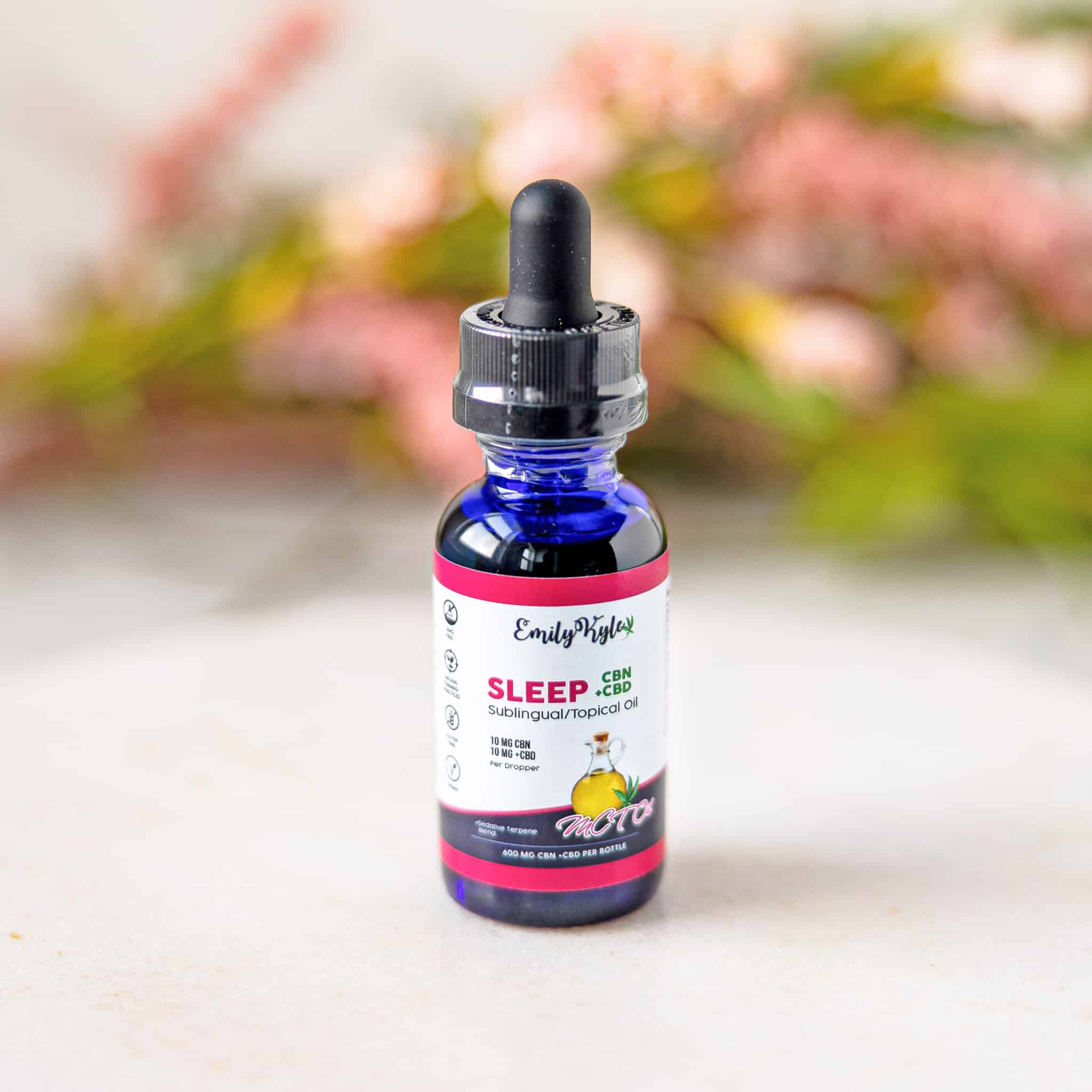
Why You Will Love This Recipe
The cannabis plant contains more than 100 cannabinoids, which give the plant its powerful properties.
While you usually hear about CBD and THC, the minor cannabinoid called cannabinol, or CBN, has been getting a lot of attention due in my Well With Cannabis Community to its unique sleep effects.
But what is CBN, why is it nicknamed the sleep cannabinoid, and is it right for you?
In this guide, we will quickly review CBN’s potential benefits, and I will show you how to use your THC-dominant flower to make your own CBN oil at home.
What You’ll Need

- THCA-dominant cannabis flower – To make a CBN oil at home, you must start with a cannabis flower that has THCA or CBNA already present. Aged cannabis is a great option, too.
- Lecithin, optional: If you’re new to working with lecithin, you can learn more about adding lecithin to edibles here. If needed, you can purchase liquid lecithin or powdered lecithin. This ingredient is optional and used for bioavailability purposes.
- Carrier oil of choice– There are many oil options to choose from. Unsure what to pick? Check out my guide to understanding different types of cannabis oils here.
Note: A complete list of ingredients with amounts and printable instructions is located in the recipe card below.
The Step-by-Step Process
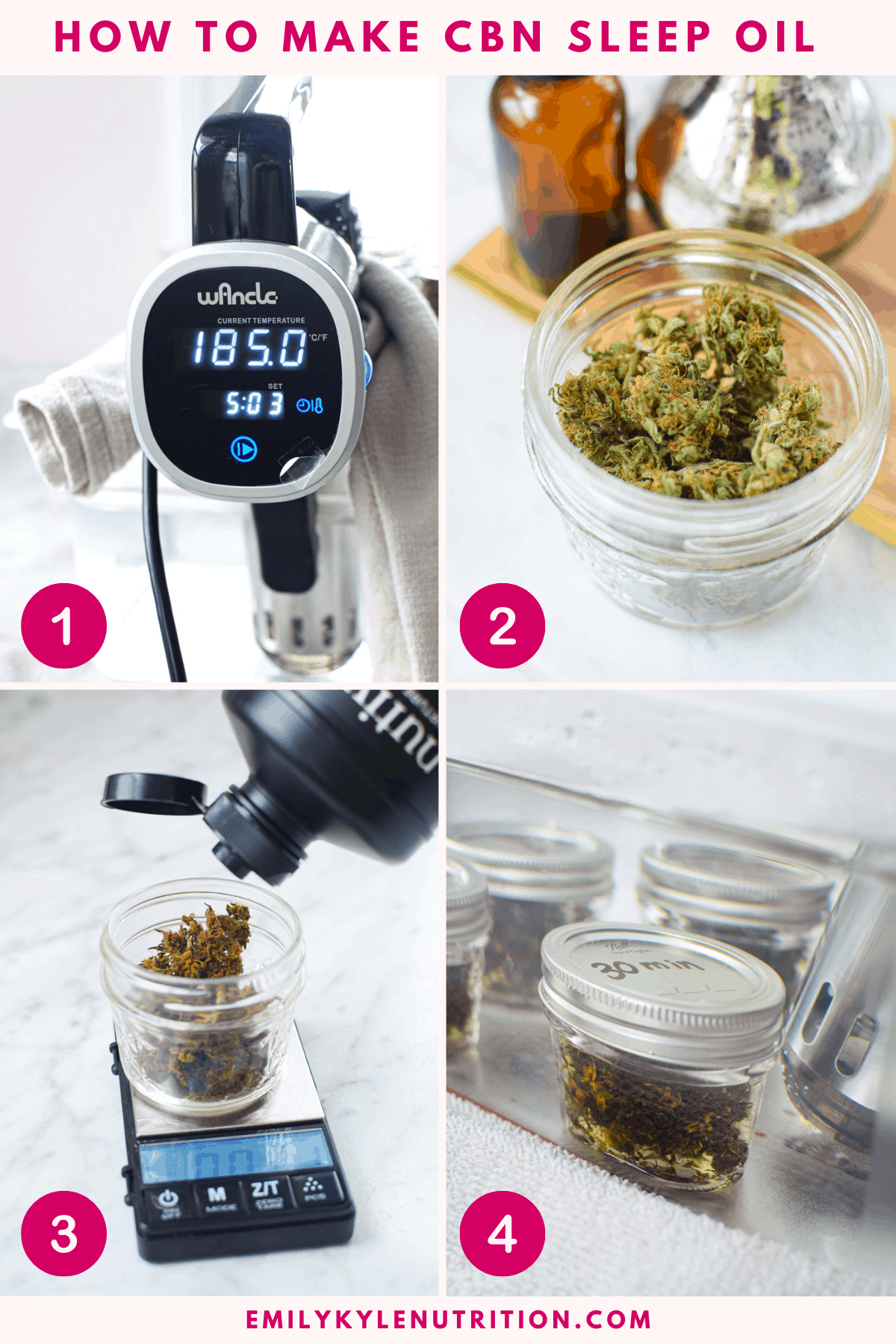
- Step 1 – The goal is to create a water bath that stays at approximately 180-190° F for the cooking process. The printable instructions in the recipe card below are for using a crockpot to create the water bath, but you can use anything you want, like an Instant Pot or sous-vide.
- Step 2 – While the water bath is heating in the crockpot, measure and decarb the THC flower. To decarb in the oven, bake the material at 240°F for 180 minutes. See more information on how to decarb for CBN below.
- Step 3 – Add the decarbed cannabis flower and MCT oil to the mason jar you plan to use. If you plan on using sunflower lecithin, add it now.
- Step 4 – Carefully place the jar into the water bath. Then, place the lid on the crockpot and leave it alone to infuse for 4 hours. After 4 hours, remove the jars from the hot water and allow them to cool.
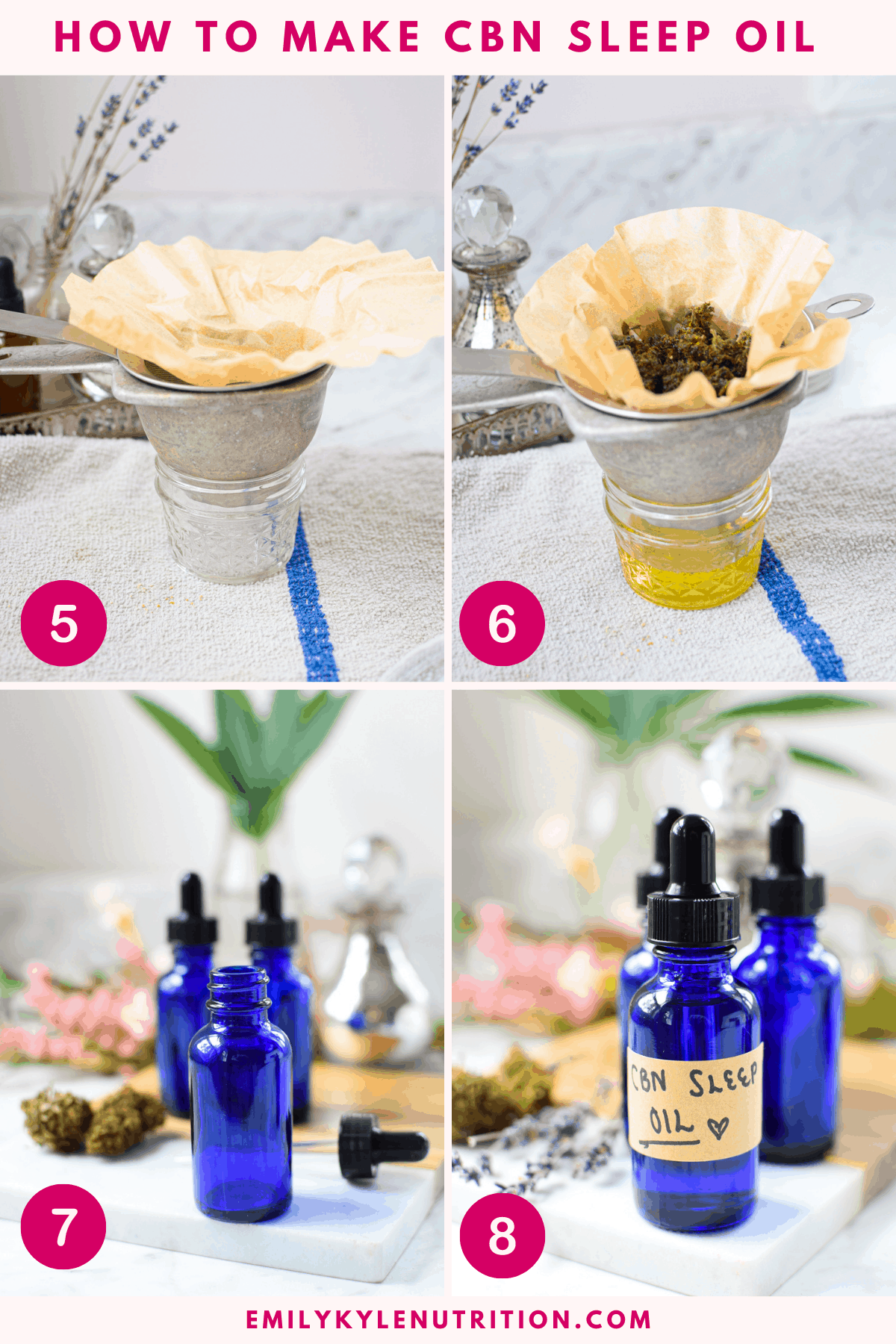
- Step 5 – Set up a straining station to separate the plant matter from the oil using a paper filter and funnel, cheesecloth, French press, or a simple coffee filter.
- Step 6 – Once cool enough to handle, strain the prepared oil with your method of choice. You can save the leftover cannabis pulp for future recipes.
- Step 7 – Return the prepared CBN oil to whatever jar you want to store it in; I use a small .
- Step 8 – Store the prepared CBN oil in a cool, dry place. It will last longer in the refrigerator and even longer in the freezer.
Note: Complete step-by-step printable instructions are located in the recipe card below.
Storage Instructions
Store your prepared CBN oil in a cool, dry place. A dark cabinet is good.
It will last longer if stored in the refrigerator and even longer if stored in the freezer.
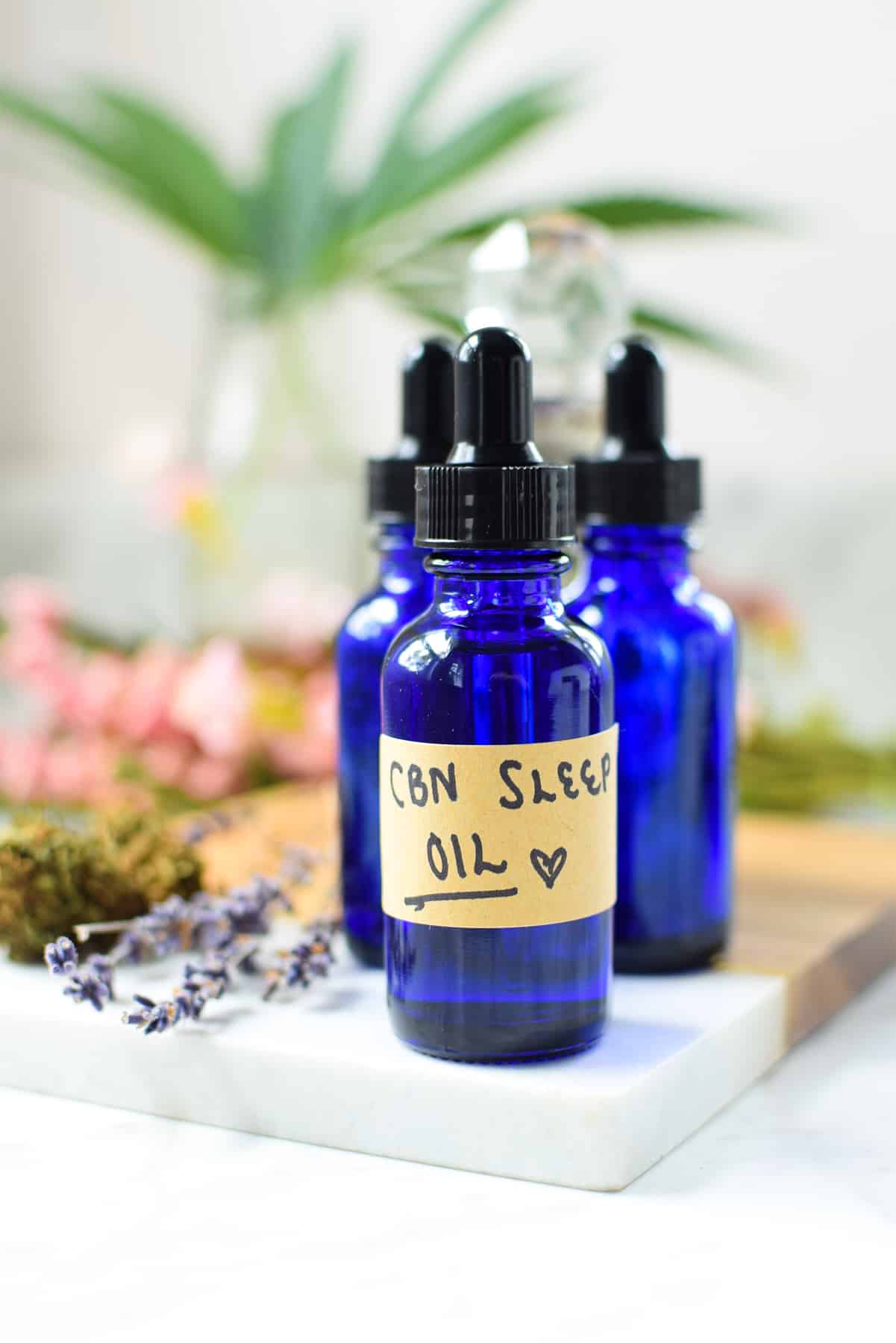
About CBN
Unlike CBD or THC, CBN is typically found in cannabis in trace quantities – also known as a minor cannabinoid.
CBN is what you might call the product of patience, slowly developing as THC transforms over time.
With a little nudge from UV light, heat, or just plain old neglect, THC starts a transformation that leads to the creation of CBN.
CBN’s claim to fame lies in its potential to produce sedative effects, offering a natural bridge to restful sleep and relaxation.
Anecdotally, members of my cannabis community often attribute CBN with the power to soothe insomnia and anxiety.
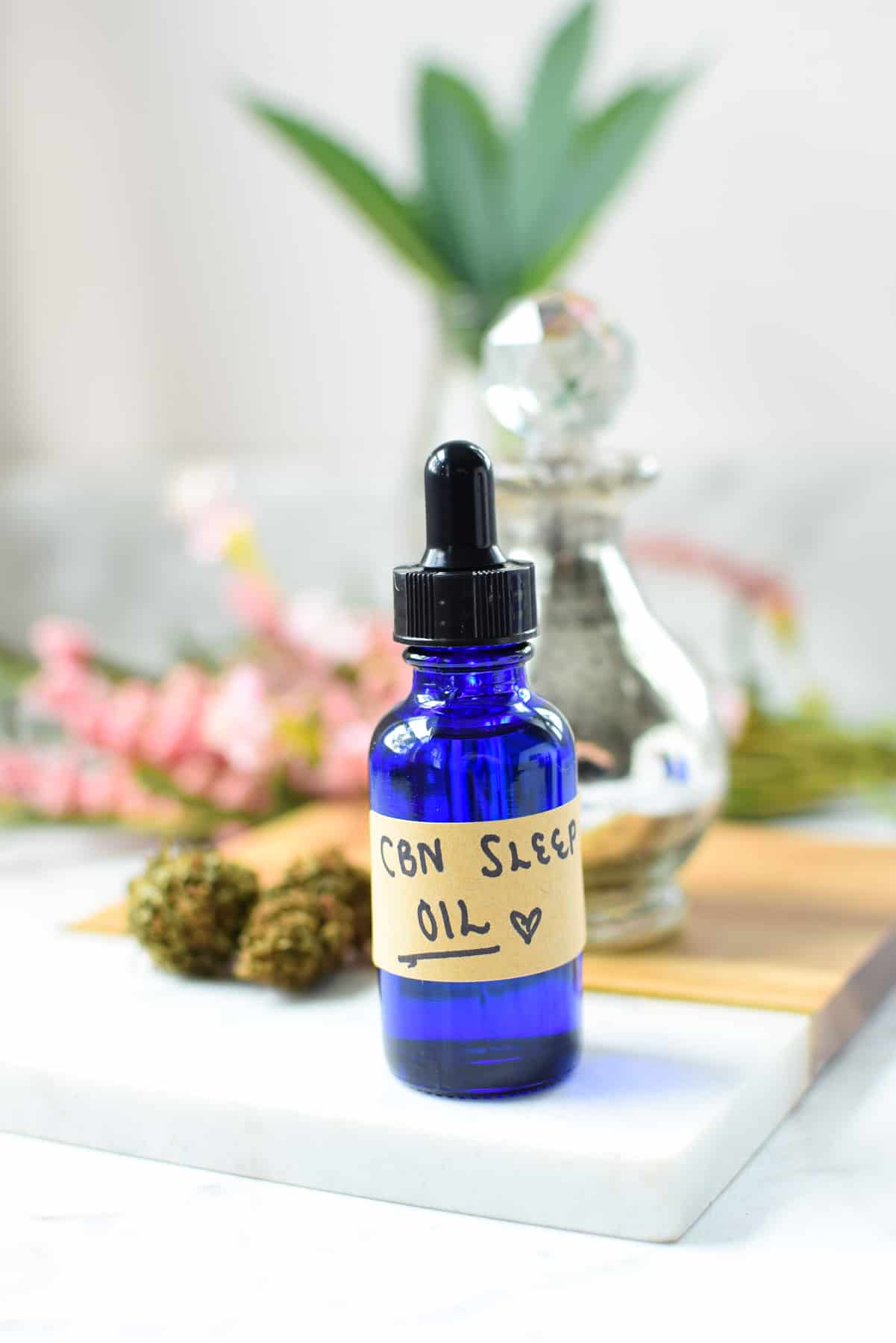
How to Create CBN at Home
Fortunately for us, CBN can be achieved through the degradation of THC, which can be done in a home kitchen through the process of decarboxylation.
This means if you have old cannabis or have exposed the THC to oxygen and/or heat, you likely already have plant material that has developed a higher concentration of CBN.
If you want to try to make your own CBN products at home, you will want to start with THC-dominant flowers.
Remember, the more THC available, the more opportunity for THC to CBN conversion.
The traditional decarboxylation recommendation for THC to CBN conversion is to decarb at 240°F for 180 minutes.
*Please note: I do not have lab tests to confirm these times and temperatures for CBN formation.
These recommendations are based on reports of what works for consumers inside my Well With Cannabis Community.
Follow this process at your own discretion, and consider starting with a small batch to start.
SAVE THIS GUIDE 💌
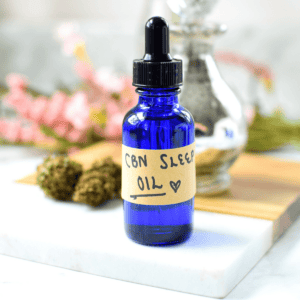
Small-Batch CBN Sleep Oil
Equipment
- Blue tincture dropper bottle
Ingredients
- 2 ounces MCT oil
- 3.5 grams THC cannabis flower
- 1/4 teaspoon liquid sunflower lecithin optional
Instructions
- Lay a clean tea towel down on the bottom of the crockpot. This will create a buffer between your mason jars and the crockpot, potentially preventing any jar from moving or cracking during cooking.
- Fill your crockpot with enough warm to hot water to cover the top of the mason jars you plan on using by an inch to create a water bath.
- While the water bath is heating in the crockpot, measure and decarb the cannabis flower in the oven at 240° F for 180 minutes. Click here for a full cannabis decarboxylation tutorial, if needed.
- If you plan on using lecithin, add it to the mason jars now.
- Evenly divide the decarbed flower between the MCT oil-filled jars. Stir well. Wipe the rim of the jars with a clean paper towel and place the lid on. Tighten the metal ring to finger-tip tightness, it does not have to be tightened all the way. Do not tighten too tightly.
- Once the water bath reaches a temperature of 185° F, carefully place the jars into the water bath.
- Place the lid on the crockpot and leave it alone to infuse for 4 hours.
- After 4 hours, carefully remove the lid, followed by the jars from the hot water. Set them aside to cool.
- Save the leftover cannabis pulp for use in future recipes. Then, return the prepared cannabis oil to whatever jar you want to store it in. We use a small amber tincture jar.
- Store the prepared CBN oil in a cool, dry place. It will last longer if stored in the refrigerator and even longer if stored in the freezer.
Notes
Nutrition
Frequently Asked Questions
You can choose whatever carrier oil you desire to make your infused oil, it does not need to be MCT oil. You can experiment with the following cooking oils: coconut oil, olive oil, avocado oil, sunflower seed oil, grapeseed oil, canola oil, soybean oil, and safflower oil.
In theory, using lecithin will make valuable cannabinoids like CBD, THC, or CBN more bioavailable or ready for use by the body. You will still have a great infused CBN oil if you don’t use lecithin; this recipe is not a make-or-break ingredient. If you use lecithin, I recommend using a liquid lecithin option rather than a powdered or granulated version, as it will mix in easier.
Store your prepared CBN oil in a cool, dry place. It will last longer if stored in the refrigerator and even longer if stored in the freezer.
More Sleep Resources For You
Articles & How-To Guides
The Ultimate Guide to CBN » For Sleep
Articles & How-To Guides
Cannabis for Sleep: Your Guide to Restful Nights
Shop with Emily
Shop Now: CBN Sleep Oil
Shop with Emily
Shop Now: CBN Sleep Gummies
Shop with Emily
Shop Now: Bliss Sleep Gummies



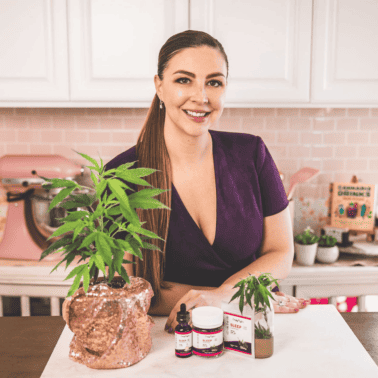
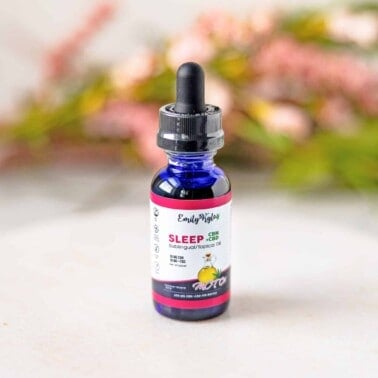

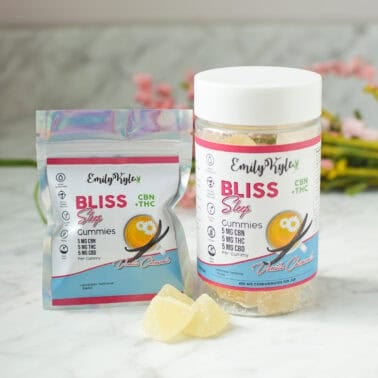









Why haven’t you extensively had 10-15 different samples tested for CBN content and remaining THC content. And be honest with the online community. You could do different cooking times and bath times.
I have read medical/lab research that we average at home people can only make at best cooking it about 10% CBN from high THC cannabis. So with that info in hand if I cooked 100mg of THC at 240 degrees for 3 hours. I would end up with 10 mg of CBN and roughly 80/90mg of THC. The problem is we are trying to get rid of the THC for the crappy next day hangover from it. The only real method unfortunately for making CBN is for a real lab to make it. Take a look into this.
I’ve been completely upfront stating “I do not having lab tests for this process”. It doesn’t get more honest than that. Lab testing, especially on the scale you’re suggesting, 10 to 15 different samples with variable cooking and bath times, requires significant funding and resources. If you’re willing to help by financing these tests, I’d be more than happy to collaborate and make it happen.
You could do one test using the method you describe in your article, and it would cost about $40-$80. I appreciate your honesty, but it does seem odd that you’re posting instructions for making CBN oil without confirming that your method works. I followed your instructions exactly, and when I tested my oil it was 100% THC, no CBN at all.
That’s a great compromise, I will work on that.
I use your recipe for infused oil with the instant pot to decarb and then infuse on slow cook. For CBN oil you say to use slow cooker at 185 degrees for 4 hours. Is the temperature what makes the difference between THC and CBN? Thank you
Thank you so much for your question, Patti! When it comes to converting THC into CBN, it’s the decarb time and temperature that play a critical role. Decarboxylating at higher temperatures for an extended period encourages the degradation of THC into CBN. The 4 hours at 185°F recommended in the infusion process is specifically for ensuring a thorough infusion of your oil, rather than for the THCa-to-CBN conversion. If your goal is to create CBN oil, you’d want to focus on the decarb step using higher heat and a longer duration to encourage more CBN production. I hope this helps clarify things!
Hi Emily, Love this site!
I’ve got Northern Lights that I grew last summer and want to convert to CBN. Do you have a sense of how much (as a rough percentage) of the THC would be left after the decarb process for CBN? I already used the NL strain for cannaoil – and it was pretty potent. I’m hoping that the decarb process would leave me with much less THC.
Separate question: do you have any recommendations for trusted labs to test cannabis? I’m interested in testing the NL and a separate Blueberry Pancake strain I grew so I know where I’m starting from on all these recipes.
Hi Ryan! Thanks for the kind words! If you decarb for the full 180 minutes at 240º, you’ll likely have a minimal amount of THC left. For testing, I’d recommend looking into local cannabis labs with good reviews — Steep Hill and SC Labs are trusted names if they’re available in your area. Good luck!
I followed the CBN instructions on this site (240° for 180 minutes) and got no CBN at all! It was all THC. That was quite a surprise.
I use Nelson Analytics in Maine for testing. $40 for a cannabinoid test.
Thanks for sharing your experience, Annika! Quick question — were you able to monitor the temperature during the decarb process? Sometimes oven temperatures can be inconsistent, so it’s worth double-checking. Did you use an oven or an Instant Pot? If it was the oven, fluctuations in temperature could have affected the results. Monitoring with an oven thermometer can help with accuracy. Let us know!
Hi! I used my oven, which has always seemed accurate. I did double-check it with a cheap oven thermometer.
I followed these instructions to make CBN oil out of some untested homegrown weed. My sleep dramatically improved, and I told lots of people how great CBD was for my sleep. Then I had a week or two of poor sleep, and decided to pony up the cash and send a sample for testing. To my surprise, the oil contained no CBN at all! It was 100% D9-THC. I’m pretty disappointed. I have been unable to find any guidance online about how I might further heat the oil to convert it to CBN – any suggestions?
Hi Annika. It sounds like the decarb process may not have been hot or long enough to convert the THC into CBN. The decarb process is essential to converting the THC to CBN. 240º for 180 minutes is what we recommend. If you ran for this time and temp and still experienced issues, I would double-check the accuracy for how you are decarbing. Many ovens vary and don’t get as hot as they say they do. Let us know if this helpful or we can continue to troubleshoot with you.
How do you determine how many drops to put into recipe for cookies, gummies etc
Hi Joe. Determining the right number of drops of CBN oil to add to your recipes depends on a few factors. Firstly, consider the potency of your CBN oil and the desired strength of the final product. A good rule of thumb is to start with a smaller amount, such as one drop per serving, and adjust based on your personal preference and the effects. Always remember to mix the oil thoroughly into your ingredients to ensure even distribution. I hope this helps!
Once the oil is made how do you dose it or make it ready to use for sleep
Great question Joe! After creating your CBN oil, determining the right dose for sleep is key. Start with a low dose, such as a few drops, about an hour before bedtime. Monitor how you feel and adjust gradually. It’s all about finding what works best for your body’s unique needs. Happy dreaming!
Great presentation. Just confirming my process which makes me feel more comfortable sharing my knowledge
Thank you for your kind words, Julia! It’s fantastic to hear this article has reinforced your process, making you feel more at ease with sharing your knowledge.
hi, im interested in making CBN oil
i have some vintaged weed (about 3 years old) which from what i understand should be good for making the oil, do i need to decarb it still?
im new to the world of making oils and edibles so would love some help
TJ
Hi TJ. Since your cannabis is about 3 years old, it should indeed have some CBN already present due to the natural degradation of THC over time. However, to maximize the potency of your CBN oil and activate any remaining cannabinoids, it’s still a good idea to decarb your cannabis.
As you’re new to making oils and edibles, the step-by-step instructions provided in this guide can be incredibly helpful for navigating the process. Feel free to reach out if you have any more questions or need further assistance. Happy oil-making!
Great article! I used a sous-vide machine (costs about $60) to heat the water (no plastic bags needed). Even though the temperature is not critical, this allows the water to remain exactly at 185F for 4 hours (plus or minus 1 degree)… That way you are 100% sure that you have the proper treatment to get the CBN.
Thank you so much for sharing your experience with using a sous-vide machine for heating water, Lee! It sounds like a fantastic and precise method to ensure you’re getting the right treatment to obtain CBN. I really appreciate you taking the time to read this article and offering such a valuable tip to anyone else reading 😊
Hi Emily,
I have been making alcohol-based tinctures, and wondering if, after decarbing for CBN, can I just steep in alcohol as usual and combine with a high-CBD / low THC tincture blend?
Hello David, absolutely, you can! 😊 After decarbing your cannabis for CBN, you can steep it in alcohol as you usually would. Combining this with a high-CBD/low-THC tincture blend should give you a lovely, wide spectrum of beneficial cannabinoids. Keep experimenting and let us know how it turns out for you!
Hi Emily! Love your recipes so much! Quick question, I do happen to have a decent amount of old cannabis laying around and would love to make use of it this way! I’m guessing the decarb time/temp may be different in this case..? Maybe not, but would love your input either way!
Thanks in advance!
Thank you so much for your kind words, Bev! I’m thrilled to hear that you’re enjoying the recipes. As for your question, old cannabis can definitely still be used for making infusions! The decarb time and temperature would generally be the same as for fresher cannabis. However, please note that the potency might be slightly lower due to the age of the cannabis. OR, you may already have more CBN present due to the natural degradation of THC. Remember to store your cannabis properly in a cool, dark place to maintain its potency as much as possible. And as always, feel free to reach out if you have more questions or need further guidance. Happy cooking! 🍴
I read old comments here, and saw that about 18 mo ago, you mentioned you might run lab tests to determine the potency of the CBN from this recipe. Have you done this? If so, what were the results? I am well-versed in making THC oil and calculating potency, but now that I’ve made CBN, I’m wondering if there’s a way to calculate potency for this. I watched a video from another source that said that THC to CBN conversion rates vary from one method to another, but I’m thinking it would be unlikely to end up with a higher CBN potency than the THCA you started with? What I mean is, if the same method (decarb/water bath) for making THC oil yielded 20mg/ml (for the same amount of flower/oil), wouldn’t the CBN potency be that or less? However, not having my own lab, I’m still left wondering. What did you find out? Thanks for your site, it’s great!
Hi there Lisa, thank you so much for your detailed question and for your kind words about the site! 😊 As of now, I have not yet conducted lab tests to determine the potency of CBN from this recipe. However, I completely agree with your reasoning. The conversion rates do indeed vary, and it’s unlikely to end up with a higher CBN potency than the THCA you started with. However, without lab testing, it’s hard to confirm this with certainty. I appreciate your interest and this definitely inspires me to consider running these tests in the future. Thanks again for your engagement and don’t hesitate to reach out with any more questions!
I made this and sent it off for lab testing and it produced no detectable CBN.
I did two batches: one with a standard 40 minute decarb and one with the full 3 hour decarb described here.
The longer decarb fully converted all the CBDA to CBD whereas the shorter had CBDA left still, but no CBN.
Hi, Nathan. Was there THC or THCA present in the material you started with? This is what is needed for CBN conversion, not CBDA or CBD.
Could this also be done in the freezer using everclear instead of an oil base?
Hi Dr ROK. Alcohol can definitely be used to create a CBN tincture. These guides will help with that process: Golden Dragon QWET Cannabis Freezer Tincture or Easy Green Dragon Recipe » Cannabis Alcohol Tincture. Happy tincture making!
Thanks for such a fantastic recipe.
Why is this called cbn ‘oil’ and not a ‘butter’? I was comparing this to the cannabutter recipe and it seems very similar apart from the cooking time in the oven but maybe I’m missing something?
Hi James. This particular recipe calls for the cannabinoid CBN and MCT oil, however, you can absolutely use butter and follow the same steps. The infusion processes are identical for oil and butter, but the decarboxylation process is different when aiming to achieve CBN. We often incorporate MCT oil into our recipes since it’s a powerful ingredient that offers many health benefits, but butter can be used instead. I hope this clears up any confusion!
You are specific about time and temp for decarb.
But you don’t give a temp on infusion.
What’s up? I thought time and temp are important … even in a crockpot.
Hi Ve. As listed in step 8 and 9 of the recipe, once the water bath reaches a temperature of 185° F, carefully place the jars into the water bath. Place the lid on the crockpot and leave it alone to infuse for 4 hours. – I hope this helps! Happy infusing!
Hi Emily and team! This was a fun recipe to follow, thanks a bunch for sharing your knowledge. I made it for a friend and they do not do well with THC and unfortunately they still feel a slight psychoactive effect from the oil I made. Is there anyway of degrading the THC even further, after the pulp has been removed and the CBN oil has been bottled?
Hello Filip, thank you so much for taking the time to try out this recipe! I am sorry to hear that they are still experiencing some psychoactive effects from the CBN oil you made. I don’t currently have any lab tests to support this, but I would try decarbing for even longer, maybe 200 minutes, to see if that could convert more of the THC into CBN. If you give it a try or find a better answer, please let us know how it turns out 😊
Can you use an ecru decarboxylator when infusing for cbn. If so how long and at what temp. Please advise
Hi Beth. We don’t have experience with the Ecru, but we recommend 240º for 180 minutes to achieve CBN conversion. I hope this helps!
I have made thc oil with mct and lethicin, if I put it back in crock pot and cook at higher temp will it turn into cbn?
Hi Julie. I’m not sure the crockpot temperature gets high enough to convert to CBN, so you can run it on high for another 4 hours. You decarbed the flower that you used in your oil, correct?
Hi Emily and team. Can you make an alcohol tincture with CBN or should you only make it with oil? I would like to combine my THC alcohol tincture with a CBN tincture to make hard candy.
Hi Denise. You can use CBN just as you would THC or CBD. The only thing different would be the decarboxylation process, but everything all other steps will remain the same. I hope this helps!
Hello love your blog.I have a question lol. I have Vaped Cannabis it’s like a mixture INDICA,hybrid,Sativa plus I have old CBD . I didn’t finish vaping. It is now to harsh to smoke.
I want to make my own gummies since they don’t offer them in my state.
I have bought everything to make Gummies. I don’t want to get Bad munchies from CBD gummies,but they maybe impossible lol. I want them for sleeping or morning.
Also I can buy INDICA Pills at my dispensary but they r $36 for 10mg pill. Heck idk what to make if I should do.
Or just make a oil to consume sublingual?
Also I do have epilepsy if maybe there is a certain cannabis I should use? Sorry so long.
Hi Melissa. There’s so many options that it can be hard to know what to do! Many of our Well With Cannabis Community members report that using AVB (already vaped bud) provides a mild, desirable, intoxicating, and often sleepy effect. If you’re looking for a sleep product, AVB would be great to use for Emily’s CBN Oil recipe. There is a process you’ll want to do prior to infusing any oils though. You can find that here in Emily’s guide on AVB: https://emilykylenutrition.com/make-avb-edibles-with-already-vaped-bud/
Decarbing Question.
On your general recommendations to make CBN (decarbing the THC at 240 degrees for 180 min)….is this for fresh bud or already aged bud? Or does it matter? I just don’t want to over cook “old bud” or undercook fresher bud?
BTW…I love your site!!! Thank you for sharing your knowledge and information!!!
Sandy
Hi Sandy. If you’re using older bud that is dry and crisp, you should definitely monitor the decarb process so it doesn’t burn the bud. You can take it out close to the end if you see it making a turn for the worse. You will only have an issue with fresh bud if it hasn’t gone through proper drying and curing. There will be extra moisture in the bud, so at the end of the decarb cycle, your bud should be golden brown and aromatic. If it’s still green and somewhat moist, you’ll want to leave it in a bit longer. I don’t think you’ll have to worry though when decarbing for CBN. I hope this helps!
I don’t feel confident myself making it can it just be bought
Hello Kim! Yes, of course, we have this CBN sleep oil for sale in our shop, and we also have CBN sleep gummies as well, depending on your preference 🙂
Are you able to use any strain of cannabis to create CBN? I thought I had read/heard that it was only Sativa. Does Indica work as well?
TIA!
Hey Evan! I have not heard the Sativa vs. Indica argument before. From everything I know, THC converts into CBN, so you would want to select a high strain in THCA/THC for conversion. High THC strains can be seen in both Indica and Sativa-dominant varieties.
Hi Emily,
I am an active 72-year-old who has struggled with insomnia most of my life. I am a lightweight (115 lb) and have a question for you…
I grow my own cannabis organically. I have quite successfully been making (Magic Butter Machine)and taking 3 ml of 1:1 THC to CBD for sleep (3ml) and was getting a full eight hours. Lately however, it hasn’t been as successful and I am assuming I have built up a tolerance level to it. I’ve been researching and there seems to be a common opinion that I would need to not take it at all for three or four weeks to reset my tolerance level. But three or four weeks of poor sleep would be devastating for me.
I don’t want to start increasing the dose… Which would probably work… as it tends to leave my head a bit stupid the next day. I’m not entirely sure what the solution is but I was hoping you might have some advice for me.
I also have made what I believe is CBN tincture made with hooch – high alcohol – and tried that for sleep a while back and didn’t find it all that great. I have not tried combining CBN with CBD. Would that help? Any other advice?
Hello Maggie, thank you for taking the time to write; I’m so proud of you for all of your adventures in cannabis. I am sorry to hear you are struggling with insomnia. Yes, we can build up a tolerance to cannabis over time. I have heard that a tolerance level can be reset in as little as 2-3 days, but I don’t know the right answer. I would assume it would be different for everyone based on how much you consume, body type, etc. I would experiment with a 2-3 day abstinence before attempting a 3-4 week one and see if that helps. Otherwise, experimenting with different cannabinoids and strains would be the next best step. Adding the CBD may help to offset the “stupid” feeling the next day. For your alcohol tincture, you can always evaporate off the alcohol to make it stronger, and burn less. I hope these suggestions help!
I also see you are a member of my private Well With Cannabis Community, feel free to share this comment there as well to see if you get more responses from the other members 🙂
I’m trying to figure out the right amount of THC flower to decarb and convert to CBN for making sleep gummies. I use your edible dosing calculator, but don’t know how to calculate for CBN. The article by Dr. Ethan Russo you link to in the CBN guide states that, “CBN maintains about ¼ the potency relative to THC.” Does this mean that to get 10mg of CBN I would need to calculate for 40mg of THC and decarb that amount?
Hey Laura! I wish I had a good answer, but unfortunately I do not currently have any lab tests to suggest or confirm how much CBN can be formed through the decarboxylation. I am not confident that is what he meant. I will add this topic to my list of lab tests to run to see if I can find a better answer for you!
I made it today and it turned out great. I took 3 teaspoons in a glass of tea and took a nice nap.
I am so happy this turned out so well for you, Linda! Thanks so much for letting us know here 😀
Question – is it only the sativa form of flower that makes CBN? I thought I saw that somewhere. Vs Indica. I want to make sure before I “degrade” the Indica flower to attempt to get CBN.
TIA!
Hey Evan! No, it doesn’t matter if the flower is Indica vs. Sativa, it matters how much THC the strain contains. The more THC present, the more opportunity there is for it to degrade into CBN. Be sure to start with a small test batch, first, to make sure it works for you 🙂